Climate Services Based on Climate Predictions and Projections
Climate predictions and projections are the basis for developing tailored climate services for communities that urgently need to implement climate adaptation plans and undertake risk management.
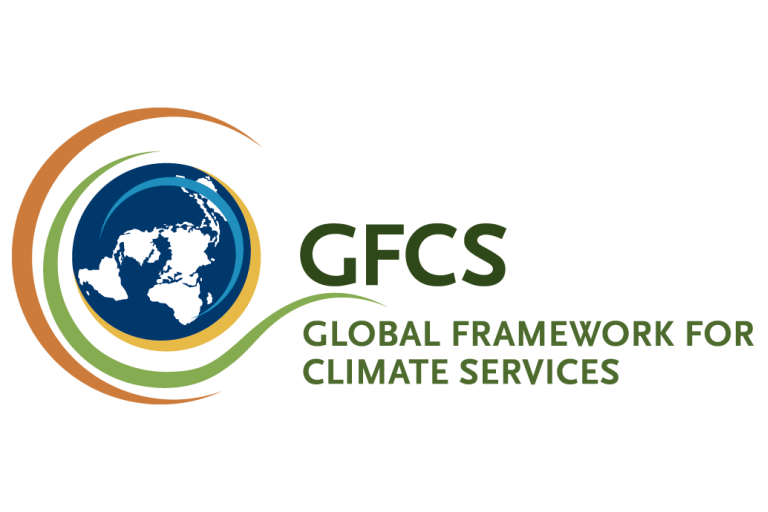
By Chris Hewitt and Wilfran Moufouma-Okia, WMO Secretariat
Climate predictions and projections, alongside observations and monitoring products, are the basis for developing tailored climate services for communities that urgently need to implement climate adaptation plans and undertake risk management. Climate adaptation and risk management in many countries and regions are being impacted by a scarcity of climate information services to guide decision-making. Many National Meteorological and Hydrological Services (NMHSs) lack either the necessary expertise, infrastructure and/or climate data – including observations and model-generated predictions and projections – to generate climate services. Having completed its initial 10-year implementation phase, the Global Framework for Climate Services (GFCS) will now focus on five areas to prioritize the development and uptake of climate information services.
Development and use of climate services
Climate services are the provision and use of climate information to improve society’s resilience to climate-related risks (Hewitt and Stone, 2021). The climate information that is contained within these services comes from a variety of sources, including observations and monitoring of the climate system, predictions of climate on monthly, seasonal and longer timescales, and multi-decadal projections of climate under various scenarios of greenhouse gas concentrations, aerosols and other atmospheric constituents that affect the planet’s radiative balance.
The services are developed and provided in a way that is intended to help the recipients of the services (hereafter referred to as the users) take decisions and actions. The services can provide people and organizations with timely, tailored climate-related knowledge and information that they can use to reduce climate-related losses and either realize or enhance climate-related benefits, thus helping sustainable development and transition to a more climate-resilient society.
Climate services have been provided and used in various ways since at least the early twentieth century when climate information started to become widely available. Originally, such services came in the form of climate records based on long-term observational datasets, then in the form of predictive information as climate models were developed. During the twenty-first century, the term climate services started to be more widely used, fueled by major advancements in developing scientific and technical capabilities. The value the services provided to society for climate mitigation and adaptation planning and to decision-makers in risk management stimulated a growing interest in the potential greater value of the services.
Advances in our understanding of the climate system and in the climate models that are used to make predictions and projections (described in the other articles in this Bulletin) are enabling the continual improvement of climate services. The advances in modelling capability are striving to provide more useful and actionable information such as for anticipating impactful events including heatwaves, cold spells, intense precipitation, coastal inundation and tropical storms (White et al., 2021, Domeisen et al., 2022).
Climate services are increasingly being embedded within decision-making and are integral within the United Nations Framework Convention on Climate Change (for example, within the Paris Agreement, UNFCCC, 2015), the Intergovernmental Panel on Climate Change (IPCC) Assessment Reports, governments’ national adaptation plans, funding agencies’ investments, and a growing number of sectors and industries worldwide.
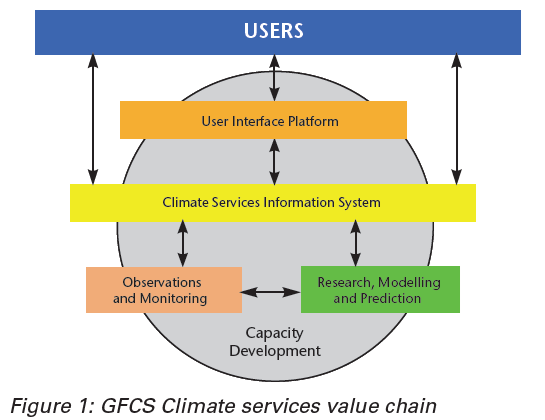
Refocused GFCS
The GFCS supports, strengthens and coordinates the development, delivery and use of climate services to assist decision-making by helping to address climate-related risks at national, regional and global levels (Hewitt et al, 2012). Heads of states, government ministers, industry representatives and scientific and technical experts called for the GFCS at the third World Climate Conference in 2009 and it was formally adopted by an Extraordinary Session of the World Meteorological Congress in 2012. The GFCS involves stakeholders from across the climate service value chain (Hewitt and Stone, 2021).
The vision of the GFCS is to enable society to better manage the risks and opportunities arising from climate variability and change, using science-based climate information. It is built on the five essential elements of the climate services value chain (Figure 1) to address the critical elements required for effective coordination, co-design, dissemination and uptake of climate services:
- Climate observations and monitoring
- Climate research, modelling and prediction
- Climate services information system
- Engagement between users and providers of climate services
- Capacity development.
The GFCS initial Implementation Plan had a 10-year horizon and focused on developing and delivering services in five targeted sectors, which present the most immediate opportunities for bringing benefits to human safety and well-being and are prominent in the National Adaptation Plans (NAPs) of many countries. The five sectors are agriculture and food security, disaster risk reduction, health, water and energy. The GFCS is now embedded within many NMHSs and climate service activities worldwide, including in the activities of WMO Technical Commissions, Regional Associations and Research Board.
The landscape of climate services has evolved significantly since the GFCS was created. Some elements have become more important, such as standardization and best practice guidance for climate services, National Frameworks for Climate Services (NFCSs) for coordination at the national scale, and creating a forum to allow broader engagement across the climate services value chain. Therefore, following decisions of the World Meteorological Congress in 2019 and of the WMO Executive Council in 2022, the GFCS has entered a new phase of implementation from 2023 with the aim to reinvigorate its activities, effectiveness, and visibility.
The refocus for the GFCS has five broad topics, summarized in Figure 2 and explained in the following five paragraphs.
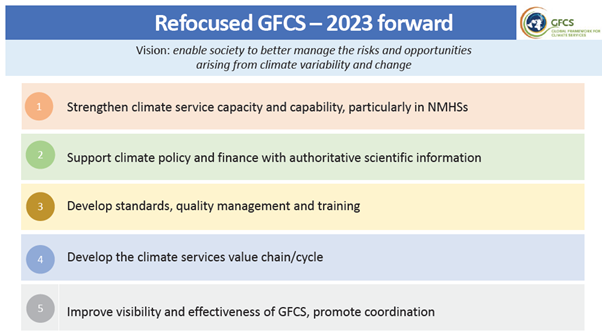
The GFCS will continue to provide a supportive environment for aligning national climate policy and investments through the development of climate expertise, tools and flagship reports with key partners. For example, the GFCS will continue to contribute to annual reports such as the global and regional State of Climate and State of Climate Services, which provide the scientific evidence base as a basis for action and feed into the UNFCCC Conference of Parties (COP) meetings each year. The GFCS has already developed various tools and methods with key partners to assist countries to incorporate climate science information into investments, plans and policies, for example with the Green Climate Fund and the European Commission.
The GFCS will continue to strengthen climate service capacities and capabilities, particularly in NMHSs as they are central to national climate service activities in most countries. The GFCS will keep collecting and analysing data on the capacity of climate service providers and the needs of decision-makers and policymakers. It will further assist with the development of NAPs to identify sector priorities and technical areas where support is needed. At the national level, it will encourage the establishment of NFCS to coordinate the development, delivery and use of climate services. Under the umbrella of an NFCS, National Climate Forums will bring key stakeholders together to discuss national climate issues, be it for monitoring the climate, to look ahead at the coming seasons and space policy makers years, or to inform longer-term climate change adaptation and mitigation decisions, depending on the specific national needs.
The essential components of the climate service value chain or cycle, and the interlinkages between them, need further development. There is a need to ensure that value is generated for the decision-makers and action enabled. There is a strong role for several WMO bodies, as well as its co-sponsored bodies, across the value chain, including its technical commissions, the World Climate Research Programme (WCRP), the IPCC and the Global Climate Observing System (GCOS).
There is a growing need to assess the capacities of climate service providers and to develop guidance on standards and competencies for climate services. The implementation of a quality management system in climate services will ensure compliance with regulatory requirements, the development of sound and consistent management practices and that stakeholder and customer requirements and expectations are met in consistent manner. Again, several WMO bodies are important here, in particular the Commission for Weather, Climate, Hydrological, Marine and Related Environmental Services and Applications (SERCOM).
Finally, the visibility and effectiveness of the GFCS need to be improved to avoid fragmentation and duplication and to facilitate and strengthen activities. As both the landscape of climate services and the need for climate information have grown, a global framework for climate services is even more important and relevant today than when it was called for in 2009. Coordination on the global, regional and national scales is essential. Moving forward, the GFCS will provide a forum for stakeholders to communicate, share knowledge and collaborate.
Climate Services Information System
The Climate Services Information System (CSIS) coordinates the development, archiving, co-production and use of climate information by decision-makers. It defines roles of agencies and other entities, such as academic institutions, in the development of climate services. It also coherently organizes different types of climate information, and facilitates technical assistance to help decision-makers understand how to integrate climate information into their planning processes.
The CSIS is the primary GFCS mechanism through which information about climate is routinely produced, archived, analysed, modelled, exchanged and processed. As the “operational engine” of the GFCS, CSIS carries out various functions through global, regional and national collaborating institutions, covering global to local spatial scales from the past into the future (Figure 3). CSIS supports the production and delivery of authoritative climate information products and facilitates interaction between the providers and users of climate services through operational mechanisms, technical standards, communication and authentication.
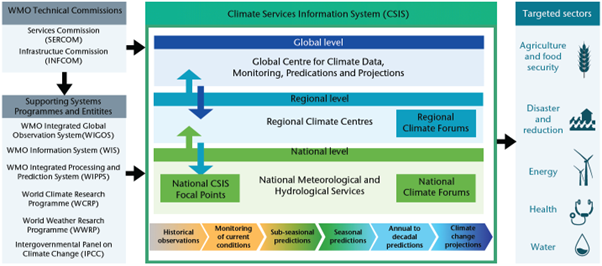
The CSIS global climate predictions and projections are enabled by 14 WMO-designated Global Producing Centres for Long-Range Forecasts (GPCs-LRF) and a Lead Centre for Long-Range Forecast Multi-Model Ensemble (LC-LRFMME) that collects retrospective and real-time forecasts from the 14 GPCs-LRF. The Lead Centre produces multi-model ensemble (MME) forecasts and verification products on seasonal to annual scales as defined by the WMO Standard Verification System for Long-Range Forecasts (Figure 4).
Near-term climate predictions — on monthly to seasonal to multi-annual timescales — are useful to inform climate adaptation and resilience decision-making and are important tools for society. Climate models initialized from the current climate state now routinely produce near-term predictions. WMO has five designated GPCs for Annual to Decadal Climate Prediction (GPCs-ADCP) and a Lead Centre (LC-ADCP) that participate in and are responsible for the collection, coordination and dissemination of ADCPs and Global Annual to Decadal Climate Updates (GADCU). Several other institutions contribute to the work being carried-out by the GPCs-ADCP, namely the Met Office in the UK, Environment Canada, Deutscher Wetterdienst in Germany, Barcelona Supercomputing Centre in Spain, and the Commonwealth Scientific and Industrial Research Organisation in Australia.
At the regional level, CSIS enablers include WMO Regional Climate Centres. These centres of excellence create climate products based on the climate predictions and climate projections in support of regional and national climate activities. Thereby, they strengthen the capacity of the NMHSs in their regions, who remain responsible for producing user-targeted climate services – products, warnings and advisories – at the national level. The NMHS in each region are the primary users of an RCC’s products, other RCCs and NMHSs in neighbouring regions may also benefit from the information generated by any given RCC.
WMO-designated GPCs-LRF, GPCs-ADCP and RCCs form an integral part of the WMO Integrated Processing and Prediction System (WIPPS), which encompasses all systems operated by WMO Members, including those jointly coordinated with other international organizations.
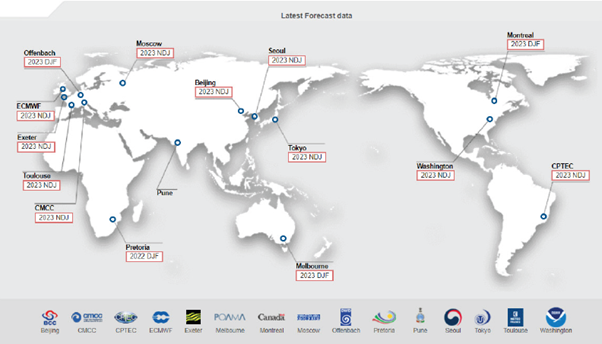
Climate model projections delivered through the Coupled Model Intercomparison Project and the Coordinated Regional Downscaling EXperiment, under the auspices of WCRP, constitute a major support for the CSIS activities on climate change timescales. These model projections are conditional on the evolution of concentrations of greenhouse gases, aerosols and other atmospheric constituents. Multi-model ensembles and large ensembles are designed to encompass the possibilities of future climate. The aim of these climate model projections is not to fully capture every detail of the day-to-day evolution of the climate system in the future, but rather to represent dominant physical processes of the climate system in ways that make these tools adequate for specific purposes. One important goal is understanding the geophysical impacts of a world where the Earth’s global mean surface temperature is more than 1.5 °C warmer than it was in the preindustrial era. While there is a broad consensus that continued greenhouse gas emissions will lead to increasing long-term warming and intensify multiple and concurrent hazards, uncertainties in the changes in climate increase as we go from global to regional to national scales.
There are several initiatives and portals that provide climate change information to users and that enhance the climate science basis for NAPs. For instance, the Vulnerability, Impacts, Adaptation and Climate Services (VIACS) Advisory Board was created to provide a strong bridge between climate change applications experts and climate modellers for the Sixth Phase of the Coupled Model Intercomparison Project (CMIP6) and to co-develop information for decision-makers managing projected risks (Ruane et al., 2016). Much of this activity is directed toward the assessment of vulnerability, impacts and adaptation of human and natural systems in relation to past, present and projected climate change. Another example is the IPCC Sixth Assessment Report Interactive Atlas that assesses fundamental aspects of observed, attributed and projected changes as well as the performance of climate models (Gutierrez et al., 2021).
Most of the available CMIP projections are provided with spatial resolutions of the order of 100 kilometres (km). Some regional climate models (RCMs) provide finer resolution projections (10–50 kilometres) through CORDEX. However, because the demand for climate services is often stimulated at subnational, national and regional scales, there is a critical need for accessing and producing climate projections with much higher resolution. For example, the Copernicus Climate Change Service (C3S) has initiated an effort, through the Climate Data Factory project, to downscale CMIP projections at around 9 km resolution over Europe, combining advanced statistical techniques and atmospheric reanalysis of the global climate covering the period from 1940 to present. Major efforts are also underway in the research community toward producing climate projections at a horizontal resolution of about 1 km, using both global and regional climate models (Schar et al., 2020). If successful, then advantages would include improved simulation of the water cycle and extreme events.
Central to all the climate service development, delivery and use are the data, information and knowledge that underpins the services. Climate models are essential tools in this landscape, to help us understand climate and climate variability better, to help fill in gaps in our observational-based knowledge of past and current climate, and for predicting what the future climate may look like. We encourage you to read the other articles in this Bulletin.
References
Domeisen, D.I., White, C.J., Afargan-Gerstman, H., Muñoz, Á. G., Janiga, M.A., Vitart, F., Wulff, C.O., Antoine, S., Ardilouze, C., Batté, L., Bloomfield, H.C., Brayshaw, D.J., Camargo, S.J., Charlton-Pérez, A., Collins, D., Cowan, T., Chaves, M. d. M., Ferranti, L., Gómez, R., González, P.L., Romero, C.G., Infanti, J.M., Karozis, S., Kim, H., Kolstad, E.W., LaJoie, E., Lledó, L., Magnusson, L., Malguzzi, P., Manrique-Suñén, A., Mastrangelo, D., Materia, S., Medina, H., Palma, L., Pineda, L.E., Sfetsos, A., Son, S.-W., Soret, A., Strazzo, S., & Tian, D. (2022). Advances in the subseasonal prediction of extreme events: Relevant case studies across the globe. Bull. Am. Meteorol. Soc., -1. URL: https://journals.ametsoc.org/view/journals/bams/aop/BAMS-D-20-0221.1/BA…. 10.1175/BAMS-D-20-0221.1.
Gutiérrez, J.M., R.G. Jones, G.T. Narisma, L.M. Alves, M. Amjad, I.V. Gorodetskaya, M. Grose, N.A.B. Klutse, S. Krakovska, J. Li, D. Martínez-Castro, L.O. Mearns, S.H. Mernild, T. Ngo-Duc, B. van den Hurk, and J.-H. Yoon, 2021: Atlas. In Climate Change 2021: The Physical Science Basis. Contribution of Working Group I to the Sixth Assessment Report of the Intergovernmental Panel on Climate Change [Masson-Delmotte, V., P. Zhai, A. Pirani, S.L. Connors, C. Péan, S. Berger, N. Caud, Y. Chen, L. Goldfarb, M.I. Gomis, M. Huang, K. Leitzell, E. Lonnoy, J.B.R. Matthews, T.K. Maycock, T. Waterfield, O. Yelekçi, R. Yu, and B. Zhou (eds.)]. Cambridge University Press, Cambridge, United Kingdom and New York, NY, USA, pp. 1927–2058, doi:10.1017/9781009157896.021.
Hewitt, C., Mason, S., & Walland, D. (2012). The Global Framework for Climate Services. Nature Climate Change, 2(12), 831–832. https://doi.org/10.1038/nclimate1745
Hewitt, C. D., & Stone, R. (2021). Climate services for managing societal risks and opportunities. Climate Services, 23, 100240. https://doi.org/10.1016/j.cliser.2021.100240.
Ruane, A. C., Teichmann, C., Arnell, N. W., Carter, T. R., Ebi, K. L., Frieler, K., Goodess, C. M., Hewitson, B., et al. (2016). The Vulnerability, Impacts, Adaptation and Climate Services Advisory Board (VIACS AB v1.0) contribution to CMIP6. Geoscientific Model Development 9 (9) 3493-3515. 10.5194/gmd-9-3493-2016.
Schär C., Fuhrer O., Arteaga A., Ban N., Charpilloz C., Girolamo S.D., et al. Kilometer-scale climate models: Prospects and challenges. Bull Am Meteorol Soc. 2020; 101: E567-E587 https://doi.org/10.1175/BAMS-D-18-0167.1
Taylor, K. E., Stouffer, R. J., and Meehl, G. A. (2012). An overview of CMIP5 and the experiment design. Bull. Am. Meteorol. Soc. 93, 485–498. doi:10.1175/BAMS-D-11-00094.1
White, C.J., Carlsen, H., Robertson, A.W., Klein, R.J., Lazo, J.K., Kumar, A., Vitart, F., Coughlan de Perez, E., Ray, A.J., Murray, V., Bharwani, S., MacLeod, D., James, R., Fleming, L., Morse, A.P., Eggen, B., Graham, R., Kjellstrm, E., Becker, E., Pegion, K., Holbrook, N.J., McEvoy, D., Depledge, M., Perkins-Kirkpatrick, S., Brown, T.J., Street, R., Jones, L., Remenyi, T.A., Hodgson-Johnston, I., Buontempo, C., Lamb, R., Meinke, H., Arheimer, B., & Zebiak, S.E. (2017). Potential applications of subseasonal-to-seasonal (S2S) predictions. Meteorol. Appl., URL: http://doi.wiley.com/10.1002/met.1654. DOI: 10.1002/met.1654.


